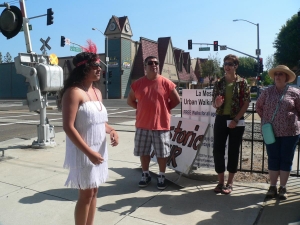 By Miriam Raftery
By Miriam Raftery
August 25, 2009 (La Mesa) –Young women in flapper costumes and men in dapper attire strolled the streets of La Mesa in mid-August, offer visitors a walk back through time to the city’s heyday as a silent movie filmmaking Mecca and a turn-of-the-century boom town.
The historical tours were all part of a project prepared by Karissa Valencia (photo, left, in white flapper dress), a Helix Charter High Graduate and incoming freshman at the University of San Diego, to earn her Gold Award in Girl Scouts.
We started our tour at the old railway depot, next to the former Lemon Grove Company. Built in 1894, the store with lemon warehouse behind is now home to a sign company, the brick façade covered in stucco. We strolled across Spring Street and up La Mesa Boulevard, once known as Lookout Avenue and later, part of historic Highway 80.
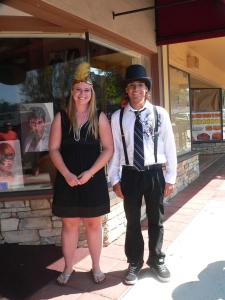
Where Cosmos Coffee and Hoffers Cigar shop now stand, there was once a hotel—until a fire leveled half the building. “Rumor has it, La Mesa Hotel was once a brothel,” our guide whispered. Next door, produce was once cultivated for the hotel—an urban garden, long before urban gardens became popularized anew.
The corner of Palm Avenue was once home to the Hotel Dorothy, where a famous Hollywood director often stayed. Alan Dwan directed Shirley Temple in “Heidi” and John Wayne in “The Sands of Iwo Jima”; his granddaughter still resides in Lakeside today.
While in town, the director would film on an open-air lot in the heart of downtown La Mesa. Over 100 one-reel movies were produced in 1911 alone; in 1920 a new wave of moviemaking occurred here via the Grossmont Studios.
 Next door, silent movies and vaudeville productions entertained crowds in the Baldridge Opera House. Today, inside the Por Favor Restaurant, you can still see the old-time balcony and arched, stain glass windows from the theater’s gilded past (photo, left)
Next door, silent movies and vaudeville productions entertained crowds in the Baldridge Opera House. Today, inside the Por Favor Restaurant, you can still see the old-time balcony and arched, stain glass windows from the theater’s gilded past (photo, left)
“La Mesa was first a movie town and gateway to the Cuyamacas,” our guide said. “It was very famous. Movies are still being produced here,” she added, noting that A&E was out just a week before filming a crime program.
Homeland Florist was once a shoe store where the proprietor shocked some patrons. “It epitomized the changes of the Roaring ‘20s by offering scandalous open-toed shoes,” our sandal-clad tour guide disclosed. Peer above the florist shop’s façade to see vestiges of red cap stone and a red tile roof,
We pass the Gidley building, which formerly housed a tavern, and an antique shop that opened in the ‘40s, starting “a trend that never left,” our guide noted.
 Gio’s Bistro Wine Bar, formerly the site of the original Drew Ford car dealer, is our town’s newest modern-day tavern. We head to Gio’s loft upstairs (photo, right) to watch a slideshow titled “La Mesa: The Early Years.”
Gio’s Bistro Wine Bar, formerly the site of the original Drew Ford car dealer, is our town’s newest modern-day tavern. We head to Gio’s loft upstairs (photo, right) to watch a slideshow titled “La Mesa: The Early Years.”
Kumeyaay Indians were the first residents of the region. Later, Robert Allison bought land here back in 1868, just three years after the end of the Civil War—and after burying three children crossing the plains from Iowa. First named Allison Springs, the town later became La Mesa. (Collier Park still has springs, where sheep were once watered and bathed.) A year later, after gold was discovered at Julian, the first hotels here were built.
Allison donated money and land for construction of a water flume and railroad. The slideshow includes historical photos of tow dignitaries riding in the flume to celebrate its opening. The flume carried water from the Cuyamacas through East County starting in 1889, culminating at Lake Murray.
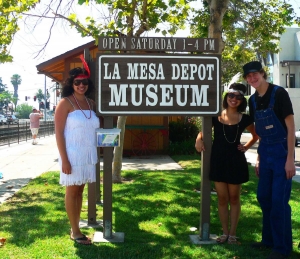 In the early days, La Mesa children took a train to San Diego to attend class, until the first school (Allison School) was built in 1895. Teachers were paid $60 a month; a bell from the original school can still be seen at La Mesa Middle School. Trains continued to run through La Mesa until the 1940s; today the San Diego trolley runs along the former railway route. Village blacksmiths proudly displayed their wares in an early parade, proclaiming “razors made to order.”
In the early days, La Mesa children took a train to San Diego to attend class, until the first school (Allison School) was built in 1895. Teachers were paid $60 a month; a bell from the original school can still be seen at La Mesa Middle School. Trains continued to run through La Mesa until the 1940s; today the San Diego trolley runs along the former railway route. Village blacksmiths proudly displayed their wares in an early parade, proclaiming “razors made to order.”
La Mesa’s volunteer fire department started in 1908, featuring Blaze, the fire dog, a bell and an air raide siren.
Gravity Boy, a new business in town, occupies a former Post Office site in a building erected during the Art Deco era complete with air conditioning—a rarity in that era.
Don Keating’s used car lot and All Things Bright and British are set back from the street, unlike neighboring buildings. That’s because the sites once housed gas stations serving motorists on old Highway 80, which was decommissioned in the 1970s when Interstate 8 opened up.
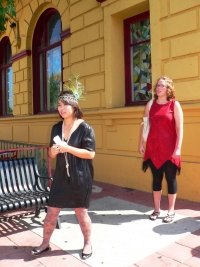
Intricate roses, arches and other historical architectural elements can be seen on the front of Risque Hair Designing, built in the roaring ‘20s. Down the street, the drugstore still stands, though sadly its vintage wooden soda fountain is long gone. The old Logan Bakery, another long-time La Mesa business, closed down a few years ago and its site is now home to a Handful of Wildflowers gift boutique.
Each building on our tour contained a plaque and historic photo.
Asked if the tours will continue after her short-term project is completed, Valencia replied, “I’ve turned everything over to the La Mesa Historical Society so they can keep this up. I hope that they will.”
We certainly hope so, too!
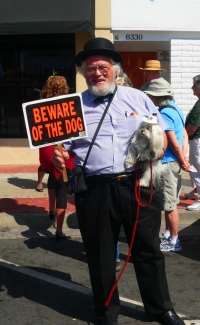
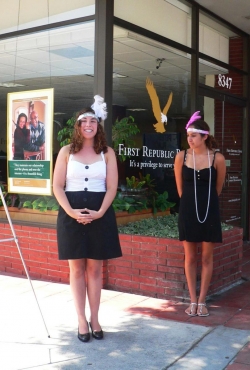














Recent comments